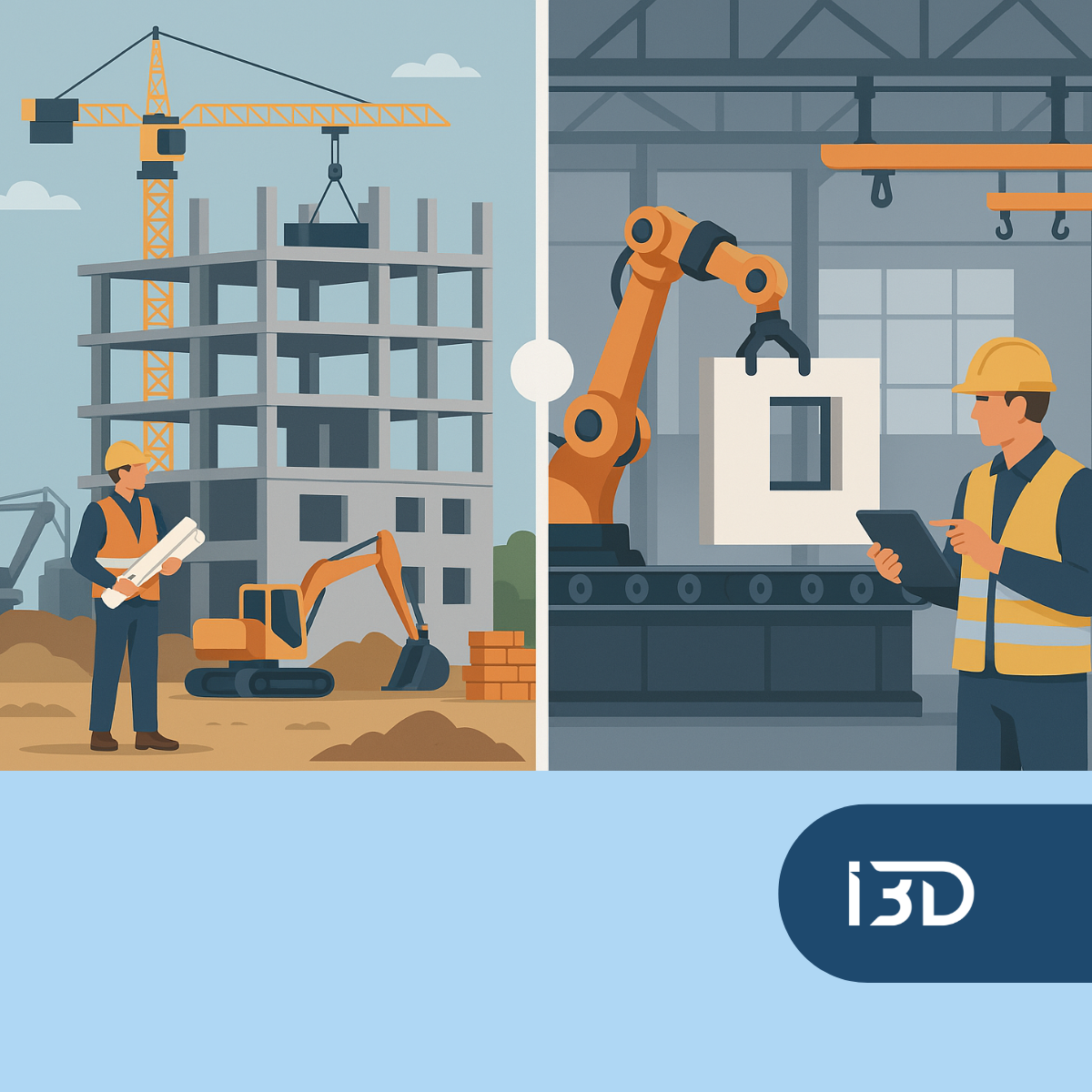Prefabricated products make construction more efficient
Improving efficiency is essential
The construction industry has traditionally relied heavily on manual work on site. Despite technological advances, the tradition remains strong, which helps to explain the challenges the sector faces in improving productivity. The labour-intensive nature of construction shows that the sector has not been able to achieve the same productivity gains as industry. This difference underlines the need to modernise construction processes and introduce new solutions.
In the long term, productivity in construction has remained almost unchanged. A comparison with industry, where productivity growth has been substantial, reveals that the construction sector is lagging behind. Even the labour-intensive service sector has seen productivity growth, while productivity in construction has stagnated at 1970s levels. The long-term stagnation in productivity suggests deep-rooted patterns of productivity that have not been addressed by the methods used.
Innovative solutions are therefore urgently needed in the construction sector. One promising approach to improving efficiency is the use of prefabricated products. The product industry has responded to this need by developing more and more prefabricated solutions. These products allow work to be transferred from buildings to factories, which can significantly improve the speed, quality and cost-effectiveness of construction.

Prefabricated products as a catalyst for efficiency
Prefabricated building solutions refer to building components or modules that are manufactured under factory conditions before being transported and installed on a construction site. The aim is therefore to shift the amount of machining to factories. Factory production offers significant advantages over traditional construction.
One of the main advantages is the reduction of manual work on site. As more and more construction work is transferred to the factory environment, the site becomes more efficient. Factory production allows for better quality control, more efficient use of materials and less dependence on the varying conditions on site.
Prefabrication also speeds up project completion times. Component manufacturing in the factory can be carried out in parallel with site preparation work, reducing the overall schedule. In turn, faster completion reduces financing costs, accelerates return on investment and reduces the disruption to the surrounding environment caused by construction.
Manufacturing under factory conditions also allows for better quality control. Standardised processes and specialised equipment in factories ensure consistent quality, which can be challenging to achieve under varying site conditions. This results in fewer errors and repairs, saving time and money.
In addition, prefabrication reduces the amount of waste generated on the construction site. In the factory, the use of materials can be optimised more precisely, and surplus materials can often be recycled more efficiently than on site. This not only reduces the environmental impact, but also lowers waste treatment costs.
Modular construction is an important form of prefabrication. For example, hotel construction can use prefabricated room modules that are simply ”dropped in place” on site. Prefabricated modules speed up the construction process, control costs and support sustainable development. Indeed, modular construction allows entire rooms or parts of a building to be manufactured in a factory.
Factors behind efficiency improvements
Several factors are driving the need to improve efficiency in the construction sector. One of the most important is the need to improve productivity. The long-term stagnation of productivity in the construction sector creates pressure to adopt methods that can bring it up to the level of other sectors of the economy. This is essential to maintain competitiveness, control costs and ensure the long-term viability of the sector.
In addition, the complexity of buildings has increased. Buildings contain an increasing number of building services and complex structures that can be time-consuming and demanding to install using traditional methods. Prefabrication allows complex installation work to be transferred to a controlled factory environment.
There are also increasing demands for faster construction speeds, as projects need to be completed faster and faster. Prefabrication offers the potential to significantly reduce construction times, which is important for both residential and infrastructure projects.
Environmental and sustainability considerations are also increasingly important in the construction sector. Prefabrication can contribute to sustainability goals by enabling more accurate use of materials, better waste management under factory conditions and easier integration of energy-efficient features into building components. Several countries have long-term strategies to achieve an energy-efficient and near-carbon-free building stock in the future. As a result, demand for building methods and materials that support energy efficiency will grow in the coming years.
Manufacturing industry’s solutions to efficiency requirements
The manufacturing industry has actively responded to the efficiency requirements of the construction sector by developing increasingly refined and prefabricated products. Manufacturers have therefore recognised the growing need for more efficient solutions in the construction sector and are investing in their development and production.
There is continuous innovation in materials and manufacturing processes. This is essential to expand the range of prefabricated building products and to improve their performance and cost-effectiveness. Advances in materials science and production technologies are enabling the manufacture of lighter, stronger, more durable and energy-efficient prefabricated components. In practice, this means optimising the use of materials.
There is also an increasing focus on modularity and standardisation. The use of standardised and reproducible building units makes design, manufacturing and installation on site more efficient and improves cost predictability. For example, harmonised product standards for prefabricated concrete and steel elements contribute to quality assurance and interoperability.
Examples of prefabricated building solutions
- Structural components: prefabricated steel frames and reinforced concrete elements allow for fast and durable construction. Load-bearing timber products such as glulam beams are also increasingly popular for their durability and aesthetic qualities.
- Facade and roof elements. In addition, insulation cladding kits are available, which include pre-installed insulation and facade cladding to improve energy efficiency and speed up installation.
- Modular units: Hotel room modules are an example of prefabricated room solutions that include all the necessary surfaces and fittings. They are manufactured in the factory and quickly installed on site.
- Interior elements: Prefabricated plasterboard elements speed up the construction of interior walls and ceilings and provide a smooth surface for finishing.
- Building services systems: small wastewater treatment systems are prefabricated units that facilitate the provision of wastewater disposal, especially in sparsely populated areas. Prefabricated fireplaces are also an example of prefabricated building services components.
Challenges and opportunities
Making use of prefabrication requires changes in the design and implementation processes. Design must move towards principles of design for manufacture and assembly (DfMA). This requires closer cooperation between designers, manufacturers and contractors from an early stage of the project. As the prefabricated elements are manufactured off-site, any design changes or errors detected on site can cause significant delays and additional costs. Careful advance planning and accurate information are therefore of paramount importance.
To facilitate site-specific customisation, particular attention must be paid to product modularity and configurability, so that customer-specific products can be efficiently produced for buildings through mass customisation.
Logistics and transport of prefabricated units bring their own challenges. Large and heavy components may require special transport and lifting equipment. Optimising logistics between the manufacturing plant and the site is therefore key to the success of prefabrication. Careful planning of delivery schedules and route optimisation can reduce transport costs and minimise delays.
Many construction projects still use a combination of prefabricated components and traditional site construction. Seamless integration of these different methods is crucial. Site scheduling and coordination of the different phases of the work must be precise to ensure that prefabricated components can be installed efficiently as part of the overall process.

The proliferation of prefabrication may also require new skills for construction workers. In addition to traditional construction skills, skills in the installation of prefabricated elements and the use of special lifting equipment will be required. Investment in training and skills development may be necessary to enable the workforce to use new methods effectively.
Economic factors have a significant impact on the uptake of prefabrication. While the initial investment in prefabricated components may be higher than for conventional materials, the long-term savings from faster build times, lower labour costs and better quality can make it an attractive option. However, current economic uncertainties in the construction sector, such as rising interest rates and inflation, may slow the uptake of new methods, which may require higher upfront investment, even if they offer long-term benefits.
Contractual and liability considerations must also be taken into account. For prefabricated components, specific contractual models have been developed that define the division of responsibilities between the different parties involved in the design, manufacture, supply and installation. Clear contractual terms are important to avoid potential disputes and to assign responsibilities at the different stages of the work.
The future of efficient construction through prefabrication
The construction sector continues to struggle with long-term productivity stagnation. However, prefabricated building products and modular construction offer significant potential to improve efficiency by reducing manual work on site, speeding up project schedules and improving quality. The growing interest in prefabrication stems from the need to improve productivity, manage building complexity, speed up construction and promote sustainability. The product industry is therefore actively developing and offering new prefabricated solutions to meet this need.
The use of prefabricated solutions is expected to continue and possibly accelerate in the construction sector as efficiency and sustainability requirements increase. In the future, new developments in prefabrication technologies can be expected to further improve their performance and cost-effectiveness.
Construction companies should actively consider using prefabrication, invest in staff training and adapt their project management processes. Product manufacturers, on the other hand, must continue to innovate and develop cost-effective and high-quality prefabricated solutions. Policy decisions can also promote the uptake of efficient construction methods, such as prefabrication. Overall, prefabrication appears to play a key role in the drive for more efficient and sustainable construction.



